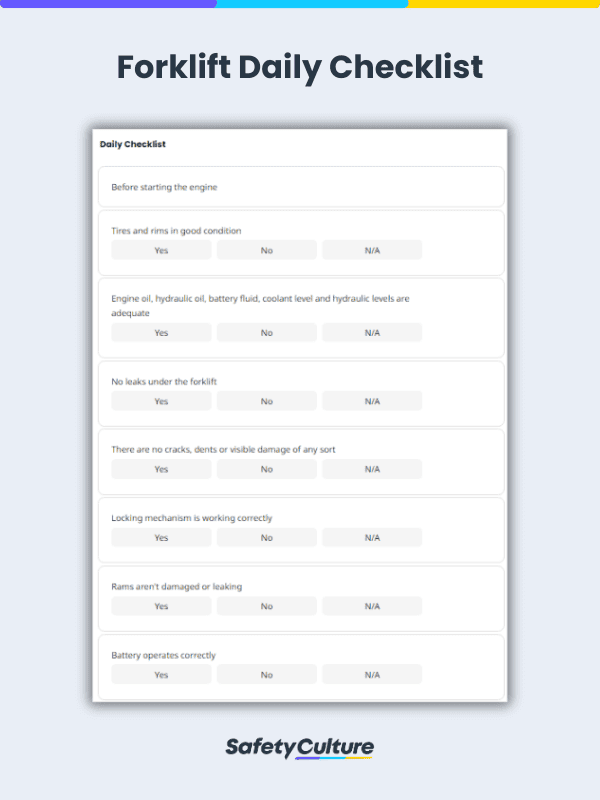What is a Forklift Checklist?
A forklift checklist is a tool used by forklift operators to ensure that powered industrial trucks are in good working condition before use. Forklift checklists are used in conducting safety inspections and maintenance checks to reduce the likelihood of avoidable injuries and deaths caused by faulty forklifts in warehouses, factories, shipping yards, and other workplaces.
OSHA Forklift Requirements
Below are Frequently Asked Questions (FAQs) about the forklift requirements of the Occupational Safety and Health Administration (OSHA) and their corresponding answers:
Does OSHA require forklift inspections?
Yes, OSHA requires forklift inspections. All industrial trucks need to be examined before use, and forklifts should not be used when the inspection reveals any condition adversely affecting the safety of the vehicle.
Does OSHA require daily forklift inspection?
Yes, OSHA requires daily forklift inspection. Operators should perform forklift pre-use checks at least once a day, but when industrial trucks are used round-the-clock, they should be inspected after each shift.
Does OSHA require a forklift checklist?
No, OSHA does not require a forklift checklist, though it provides sample forklift checklists for various types of industrial trucks and, as mentioned previously, requires daily forklift inspections. According to OSHA, operators should modify forklift checklists based on the owner’s manual, specifications, manufacturer’s recommendations, and other workplace needs.
Aside from conducting forklift inspections (which can be facilitated by the use of checklists), OSHA also requires all forklift defects to be reported immediately and those qualified mechanics correct them.
4 Essential Forklift Tips for Operators
Failure to inspect powered industrial trucks before use is one of the most cited OSHA violations in terms of forklift safety. Here are some guidelines to help forklift operators conduct forklift inspections and perform pre-operational, safety, and maintenance checks easily.
Tip #1: Inspect from the outside-in during engine off checks
It can be easier for operators to perform the necessary pre-use inspections by practicing the outside-in technique for assessing the safety of a forklift.
What should I check before operating a forklift?
- Check the condition of tires, forks, and load backrest extensions.
- Check the safety decals and nameplates and ensure that they are clear and visible, especially for load capacity details.
- Check the fluid levels, including but not limited to oil, water, and hydraulic fluid.
- Ensure that the operator manual is onboard before mounting the lift truck.
- Wear the appropriate Personal Protective Equipment (PPE).
- Practice proper ergonomic procedures to avoid slipping or tripping upon entry.
Tip #2: Investigate unusual noises during engine checks
Forklift operators should immediately report unusual noises or vibrations during operational inspections. They should also do the following:
- Check if the seat belt works and wear it at all times.
- Look out for leaks in the operator compartment, especially while the engine is running.
- Test the brakes, controls, and steering operation to ensure that they are functioning properly.
- Test the forklift’s horn, lights, and alarms.
- Keep an eye out on the hour meter and battery discharge indicators when operating an electric industrial truck.
Tip #3: Be mindful of potential hazards for removal from service
While driving, be alert for potential fire, leakage, overheating, and mechanical breakdown. If any of these defects among other safety issues are detected, forklift operators should stop, park the vehicle, and get help. While meeting deadlines and getting the job done matters, your safety and the safety of those around you matter more.
Tip #4: Schedule preventive maintenance inspections regularly
Regular maintenance is crucial to keep the safe operation of forklifts. A sign that could mean lift trucks are overdue for their adequate maintenance is when they skid or slide while in operation because of grease and spills. During preventive maintenance, check if powered industrial trucks are free of debris and lint to avoid improperly working controls.
The Impact of an Inefficient Forklift Inspection Process
Your forklift operators need to lift heavy loads, safely navigate through aisles, and watch out for pedestrians. They need to do all these and more as quickly as possible. Aside from those responsibilities, they also need to conduct regular forklift inspections. Whether you’re a supervisor in a warehouse, construction site, or manufacturing plant, the gravity of the forklift inspections conducted by your operators can’t be taken for granted.
Forklifts are crucial in your business’ logistics, thus you ensure inspections are performed consistently and efficiently. You are aware of the extreme consequences a single, inoperable forklift can cause to your operations.
E-commerce giants eBay and Amazon estimate their forklifts’ downtime value at whopping costs of $3,750 and $3,000 per minute, respectively. Reduce eBay’s downtime value by 95%, and smaller businesses can still lose a significant amount of $11,250 per hour.
On top of an inoperable forklift’s financial impact, other repercussions can include employees getting stressed because of the tense environment and, ultimately, your company’s reputation suffering due to unfulfilled customer demands.
Forklift inspections can mean the difference between profit and loss, which is why they need to be completed as effectively and efficiently as possible. If your operators currently use paper checklists for forklift inspections and you’ve begun to recognize its pitfalls, you might be looking for a solution that can resolve those drawbacks. Take a look at your current forklift inspection process and see if a more modern and digital solution is what you and your operators need.
Disadvantages of Using Paper Checklists for Forklift Inspections
Here’s how forklift operators typically complete inspections with a paper checklist:
- Operator logs findings on a printed forklift checklist
- If there’s a noted defect on the forklift, the operator shall immediately take a picture of it with a camera and tag the forklift as “Out of Service”
- Once the inspection is completed, the operator takes a trip to the office to (a) submit the report to the shift supervisor for record-keeping; and (b) report the defect to the supervisor and maintenance personnel and request repair for the forklift
On the other hand, shift supervisors need to undertake all (or at least some) of the following tasks when forklift operators use a paper checklist for their inspections:
- Upon receipt of the accomplished checklist and report from the operator, the supervisor makes their own report to management via a word processor
- The supervisor retrieves the pictures from the operator, uploads them to their PC/laptop, and attaches them to the report
- Once the report has been finalized, the supervisor either prints it for submission, or they convert it to PDF and email it to the higher-ups.
This paper-based inspection poses challenges that you may have already noticed in your everyday workflow. This can include the hassle of collating necessary documents to create a report, piles of paperwork in your office, and delays in communicating forklift issues.
As highlighted previously, you know that time is gold in forklift operations, and you shouldn’t allow these issues to continue crippling your forklift safety program.
As one of the main people who manage forklift safety in your workplace, you may have asked yourself if it’s time for a change and considered a forklift inspection app as a solution. If this is the case, we’ll share with you the advantages you and your forklift operators can enjoy with a forklift app like SafetyCulture (formerly iAuditor).
What Should be Included in a Forklift Safety Checklist?
The contents of a forklift safety checklist should, at the minimum, include all essential parts of the forklift being checked and consider the type of inspection to be done involving the forklift. The most basic forklift checklist is divided into two sections: pre-start or pre-operational and after starting the engine.
Pre-start or Pre-operational
During pre-start, the following, among other things, are checked:
- Tires and rims
- Engine oil, hydraulic oil, battery fluid, coolant level, and hydraulic levels
- Possible leaks
- Visible damage
- Locking mechanism
- Rams
- Battery
- Engine bay
- Load plate
- Overhead and backrest guards
- Operator’s seat
- Controls
- Seat belt
After Starting the Engine
The following are checked after starting the engine to make sure they will function during operations:
- Controls, pedals, and indicators
- Revers buzzer and beacon
- Lights and flashing strobe
- Steering wheel
- Park brake and foot brake
- Hydraulic lift



